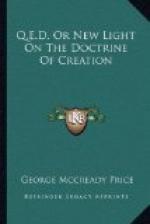Joule worked out the mechanical equivalent of heat by means of his now famous experiment of churning water. He reasoned that if the heat produced by friction, etc., is really energy in another form, then the same amount of heat must always be generated by the expenditure of a given amount of motion or mechanical work. And this must be true, no matter whether this work is expended in overcoming the friction between wood on wood, iron on iron, or in any other conceivable way. Accordingly, he devised an experiment in which paddle wheels were made to rotate in a vessel of water by means of falling weights somewhat like the weights of a clock. The amount of work represented by the falling of the weights was easily calculated, and so was the amount of rise in temperature of the water caused by the friction of the water with the rotating paddle wheels. In various other ways he measured the amount of heat generated by a measured amount of work; and as the result of all his experiments (with very slight corrections made since by means of more exact apparatus), we now know that 778 foot pounds of work produce heat enough to raise one pound of water one degree Fahrenheit; or stated in the metric system, 427 kilogram meters of work will produce a calorie of heat.
Since these record-making experiments by Joule, the matter has been verified over and over again in all sorts of ways; and almost every kind of display of energy has been measured with more or less exactness. Even the amount of food oxidized in the human body is now known to be capable of correlation with the other forms of energy, though necessarily very minute exactness of measurement is scarcely attainable in this case. But no scientist of to-day doubts that all the physiological processes of animals or of plants conform exactly to the law of the conservation of energy that energy is neither created nor destroyed by any means known to science. In other words, the amount of energy in our world, if science can at all determine such a matter, seems to be a fixed quantity, gradually being dissipated into space, it is true, but momently replenished from the sun at exactly the same rate now as hundreds or thousands of years ago. And while this energy is in our world it is always capable of exact correlation in all of its multitudinous forms, and is transformable back and forth without increase and without loss.
On the discovery of the radioactive substances in 1896, some persons hastily concluded that the law of the conservation of energy was contradicted by the astonishing way in which these substances acted. But further and more accurate experiments have set this matter at rest, as indeed might have been expected; for the law of gravitation itself is not more immovably established in the make-up of the universe than this magnificent law that energy cannot be created by any means which we call natural.




